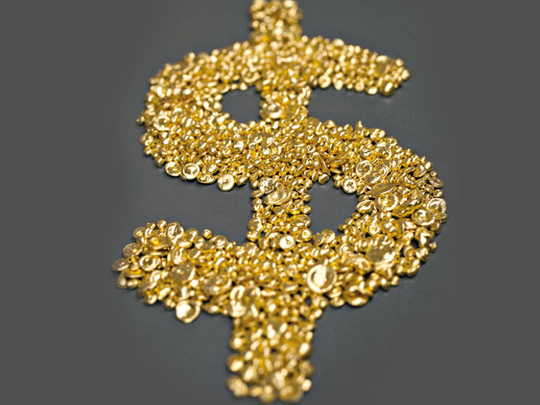
With gold prices tumbling more than three per cent on Thursday to end the day below $1,200, is "the ultimate asset bubble," a phrase coined by George Soros, on the path to finally bursting? In March, investment banks such as Goldman Sachs, Barclays Capital and HSBC Holdings however predicted gold would record further gains — some economists saying it would reach $1,300 (Dh4,775) an ounce by year end — before the gold bubble pops.
The precious yellow metal reached new highs last month when it breached $1,265 an ounce on safe haven buying as investors got nervous on the fiscal instability of the indebted Eurozone, prompting them to sell euros and equities. Since then, gold prices have come down and were hovering at $1,235-$1,242 until Thursday, when it fell 3.38 per cent to $1198, the biggest one day drop since February.
Most commodity traders and investment managers agree that it is not possible to clearly determine whether gold is in bubble territory, though some signs might suggest so. Some say gold prices will continue to rise but others accept that there is a risk to aggressive price rises. Bubble or no bubble, asset managers of the region are all in favour of allocating a small portion of their portfolios to gold (see below).
"If gold is a bubble or just in a bull market, only time will tell," says Jeffrey Rhodes, chief executive of INTL Commodities, Dubai, adding that there will be sustained volatility over the summer.
Investment demand has been a dominant factor in driving prices until now. The demand of paper gold, proxied by US Commodity Futures Trading Commission's reported managed money long contracts, have since the end of 2006 risen in tandem with the price of gold. Managed money is a category comprising funds that serve clients wanting speculative or investment exposure to commodities.
"This largely speculative segment may be the first one to exit the gold market in the case the price premises are challenged by the market," says Deon Vernooy, senior executive officer at Emirates NBD Asset Management Group.
Traditional valuations measures for gold also seem to be stretched. "Currently one ounce of gold buys 16.7 barrels of oil against long-term mean reversal level of 13.7 barrels and a cyclically adjusted level of 7.73," says Vernooy.
The high gold price relative to the cost of production will also continue to attract additional investment into the gold production sector which will eventually lead to an increased supply of the metal. The global gold supply was up by 29 per cent year-over-year in May compared to a decline of 15 per cent in demand over the same period. While some see the possibility of a sharp decline as early as this summer, which might already have started with Thursday's fall, the eventual reversal is more likely next year. That's when the US Federal Reserve is expected to raise interest rates as economic recovery gathers pace.
"Once the Fed starts to tighten monetary policy and real interest rates increase, it could signal the end of the current bull market," says Rhodes. "When will this be? Perhaps sometime in mid-2011, although your guess is as good as mine."
Unsustainable
In April, a London-based precious and base metals and steel research consultancy GFMS said the current price of gold, which has limited industrial use, is unsustainable in the long term and have to fall to stimulate demand in the jewellery sector.
The GFMS report also said the large volume of gold investment as seen in 2009 is unlikely to be maintained, as central banks raise interest rates as they undertake their exit strategies and put an end to the era of liquidity injections that were required to keep the global economic vessel afloat.
Also, as Pradeep Unni, senior analyst at Dubai-based Richcomm Global, says physical demand in India, the Middle East and other key demand markets has been lacklustre due to the surge in price. In fact, gold imports fell 50 per cent to 17 tonnes in May from the previous month, according to the Bombay Bullion Association.
"The yellow metal is very price sensitive and the decline in demand will have to be finally reflected in the prices. Weighing these factors, gold at least carries a 10 per cent price risk from the current levels," Unni says.
Declining sales of gold can also lead to volatile prices, warn some investment managers.
The divergence between low sales in India and growing investment demand in Europe could lead to increased volatility in price, says Dan Dowding, managing director of Killik and Co. Middle East and Asia.
Gold may be a hedge to most financial and geopolitical turmoil, but historically it has been dumped immediately after the dust settled. The degree of price correction has been steep many times in the past decade.
In 2008, for instance, gold dropped 12 per cent in a single week — from $1,030 to $904 — and the same in December last year in three weeks, from $1,226 to $1,074. Bulls argue these price drops are normal and that no bull markets are without wrinkles.
Dowding says their outlook from the current levels is positive on gold, though he does not rule out extreme volatility. "I would not be surprised to see $1,350, but the price will be volatile. If an investor enters at these levels [he] should be prepared to see $1,175 or $1,140 on the downside, and we would be looking to add to positions or buy new positions on weakness," he says.
Inflation or deflation, gold will still be a favoured investment choice for some time, say other analysts.
"Demand for gold is negatively correlated with confidence in the solvency of the sovereign issuers and uncertainty over currency's inflation or deflation. Today, we have the worst of both worlds so demand for and the price of gold is headed up," says New York-based Societe Generale analyst and Gulf News columnist Keerthik Sasidharan.
Historical pricing
"And historically gold is still under-priced compared to the amount of money that has been issued assuming one had to back all issued monies by gold," Sasidharan says.
Also, with tension between the dollar and gold behind us, says Sasidharan, until uncertainty continues, it wouldn't be surprising if the two continue to gain strength.
But as Unni says, markets are dynamic and forecasting the perfect target is difficult.
"Yes the trend is strong, the bullish momentum is intact, but the rise to $1,500 would only increase the steepness of the price correction. Investing in the metal reading the macro news isn't enough as the gold market is more of a ‘tangled web' with too many factors playing at the same juncture and no factor can be discounted to the other," he explains.
Investing in gold as part of your portfolio
You don't have to tell Indians or other Asians to buy gold. Indians as we know are the largest consumers of gold in the world. All the physical gold — jewellery, gold coins and bars — the Indians buy are mostly stored in vaults. But for those who have not invested in gold it might be wise to allocate a small part of their portfolios to gold, say investment managers. Diversification is key to any asset allocation, even if current prices are on the steeper side and a correction cannot be ruled out.
Individual circumstances, need for income and growth, risk appetite and need for liquidity — determine how much to invest in the shiny metal.
"What gold does is it is a diversifier," said Alan Durrant, chief investment officer at National Bank of Abu Dhabi. "At times of confusion, at times when markets are volatile, gold can be an asset class that investors turn to."
The reason for diversification under the present economic circumstances is the huge amounts of debt that the world is facing and most importantly a lot of that debt is in some of the biggest economies, including Japan, the United States and some of the Eurozone economies.
"If you have that significant risk in the backdrop of countries that could default, then gold is a much more relevant asset in the portfolio," says Gary Dugan, chief investment officer of Emirates NBD's Private Banking Group. "It is a very good hedge against those kinds of risks. Putting a price on it is difficult but people go back to long-term charts and can justify gold price at $3,000, though that is on very, very long term valuations."
All portfolio managers interviewed by Gulf News suggest investment ranging from five to 10 per cent in gold. The investment could be in different forms (see box, above right).
Gold is still very under owned by western investors, says Dan Dowding, managing director, Killik and Co, an independent wealth management and stock broking company, with offices in the UK and Dubai.
"Depending on the type of portfolio we have allocated up to 5 per cent in gold via an exchange traded funds the BlackRock Gold and General Fund — a fund that invests in the equities of gold mining companies (where the equities are trading a discount to the gold price)."
At NBAD portfolio managers structure exposure to gold for investors. "We do them on a bespoke basis," Durrant says. "The first decision you have to take is whether you want to be exposed to the physical metal, or some sort of derivative or you want to invest in gold mining shares." He is mindful to point out that an investor should only invest in things that he or she actually understands. "So if you have a leveraged exposure to gold, which is a small part of your portfolio, that may still be okay."
What about the downside if gold prices tumble? "If the world comes down, if there are less concerns on sovereign default, if the currencies are trusted once more, equity markets go up, well yes, gold may come down," says Durrant. If it does that, then 95 per cent of your portfolio which isn't in gold will do really well, he says But if the rest of the world falls apart, then having an exposure to gold "is at least going to alleviate some of your pain."
Ways to invest in gold:
Physical Gold Coins / Gold Bars / Jewellery: You can buy the physical gold and store it at home. There's a very low crime rate in the UAE. But clearly there is a risk if you hold a large amount of gold at home. But as Dowding points out, the concerns could be one of quality, the premium charged by the seller, secondary market, and the cost of holding physical gold (insurance / bank safety deposit).
Exchange Traded Funds: Many experts suggest an ETF is a good and cheap way of having investment exposure to gold, with ETFs being backed by physical gold. "It will provide a purer play on the gold price than small bars and coins, therefore a lower risk way of getting gold exposure (other than price volatility)," says Dan Dowding.
Surge in Gold ETFs — with some backed by physical gold, some not — has contributed to the rise in gold price over the last few years and western investors have started to add exposure to their portfolios. Investment funds (Gold ETFs) have siphoned off almost 1,316.177 tonnes of gold through the ETF route till date out of the markets. It's a must to remember that these record holdings of gold by the exchange-traded funds (ETFs) are higher than the reserves of many nations, including that of China and is also nearly half of yearly mine production.
"So if investors start dumping them, physical gold will be sold. Whether this impacts the price will be down to what demand there is on the other side for the gold," says Dowding.
There is risk in investing in gold through the ETFs says Pradeep Unni of Richcomm Global because of the weight of the gold holdings that each fund carries. "In addition an investment in many of the ETFs that track gold prices do not consist of actual gold ownership on the part of the shareholders.
ETF funds are also exposed to a host of company risks that have nothing to do with the actual fluctuation in gold's value."
He points out to the prospectus of SPDR Gold Trust, the world's largest gold-backed exchange-traded fund, in which it says the trust can liquidate if there is less than $350 million in the trust, if the net asset value (NAV) drops below $50 million, or by agreement of shareholders owning at least 66.6 per cent of all outstanding shares. These actions can be taken regardless of whether gold prices are strong or weak.
Fund: Investing in equities of gold mining stocks, typically trading at a discount to the gold price. These tend to be well diversified, however an investor is not getting pure gold price exposure and is subject to operational, corporate risk (of those companies the fund invests in) as well as (stock)market risk . The BR Gold & General has comfortably outperformed the gold price (and the stock market).
Futures Contracts: Investors trading futures contracts in gold on the Dubai Gold and Commdities Exchange are able to buy or sell the metal at their discretion. Other advantages include no management fees, no third parties making decisions on investors' behalf, and investors can at any time decide to own the underlying gold, square of the trade before the expiry or roll over to the next month contract. But there is the risk of high leverage in futures trading. But because of margin leverage in futures, the returns on investments are high.
All carry different risks, and all investors with their different requirements and risk appetites must decide for themselves which way to invest.








